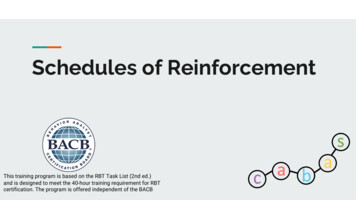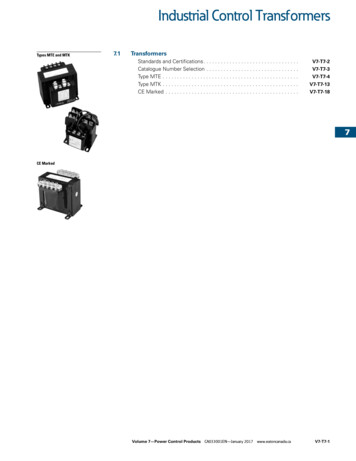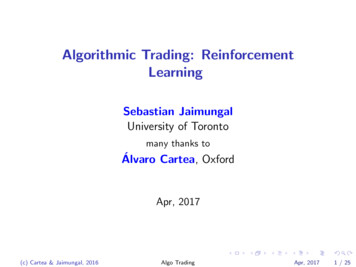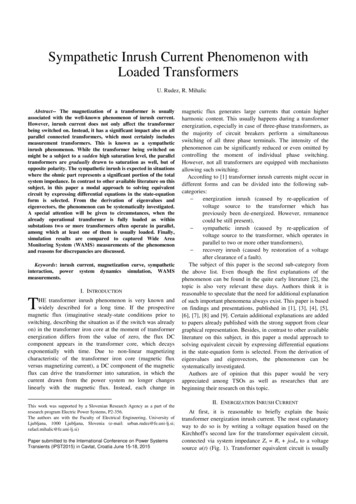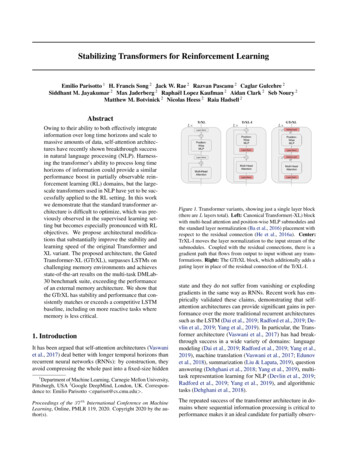
Transcription
Stabilizing Transformers for Reinforcement LearningEmilio Parisotto 1 H. Francis Song 2 Jack W. Rae 2 Razvan Pascanu 2 Caglar Gulcehre 2Siddhant M. Jayakumar 2 Max Jaderberg 2 Raphaël Lopez Kaufman 2 Aidan Clark 2 Seb Noury 2Matthew M. Botvinick 2 Nicolas Heess 2 Raia Hadsell 2AbstractOwing to their ability to both effectively integrateinformation over long time horizons and scale tomassive amounts of data, self-attention architectures have recently shown breakthrough successin natural language processing (NLP). Harnessing the transformer’s ability to process long timehorizons of information could provide a similarperformance boost in partially observable reinforcement learning (RL) domains, but the largescale transformers used in NLP have yet to be successfully applied to the RL setting. In this workwe demonstrate that the standard transformer architecture is difficult to optimize, which was previously observed in the supervised learning setting but becomes especially pronounced with RLobjectives. We propose architectural modifications that substantially improve the stability andlearning speed of the original Transformer andXL variant. The proposed architecture, the GatedTransformer-XL (GTrXL), surpasses LSTMs onchallenging memory environments and achievesstate-of-the-art results on the multi-task DMLab30 benchmark suite, exceeding the performanceof an external memory architecture. We show thatthe GTrXL has stability and performance that consistently matches or exceeds a competitive LSTMbaseline, including on more reactive tasks wherememory is less critical.Figure 1. Transformer variants, showing just a single layer block(there are L layers total). Left: Canonical Transformer(-XL) blockwith multi-head attention and position-wise MLP submodules andthe standard layer normalization (Ba et al., 2016) placement withrespect to the residual connection (He et al., 2016a). Center:TrXL-I moves the layer normalization to the input stream of thesubmodules. Coupled with the residual connections, there is agradient path that flows from output to input without any transformations. Right: The GTrXL block, which additionally adds agating layer in place of the residual connection of the TrXL-I.Department of Machine Learning, Carnegie Mellon University,Pittsburgh, USA 2 Google DeepMind, London, UK. Correspondence to: Emilio Parisotto eparisot@cs.cmu.edu .state and they do not suffer from vanishing or explodinggradients in the same way as RNNs. Recent work has empirically validated these claims, demonstrating that selfattention architectures can provide significant gains in performance over the more traditional recurrent architecturessuch as the LSTM (Dai et al., 2019; Radford et al., 2019; Devlin et al., 2019; Yang et al., 2019). In particular, the Transformer architecture (Vaswani et al., 2017) has had breakthrough success in a wide variety of domains: languagemodeling (Dai et al., 2019; Radford et al., 2019; Yang et al.,2019), machine translation (Vaswani et al., 2017; Edunovet al., 2018), summarization (Liu & Lapata, 2019), questionanswering (Dehghani et al., 2018; Yang et al., 2019), multitask representation learning for NLP (Devlin et al., 2019;Radford et al., 2019; Yang et al., 2019), and algorithmictasks (Dehghani et al., 2018).Proceedings of the 37 th International Conference on MachineLearning, Online, PMLR 119, 2020. Copyright 2020 by the author(s).The repeated success of the transformer architecture in domains where sequential information processing is critical toperformance makes it an ideal candidate for partially observ-1. IntroductionIt has been argued that self-attention architectures (Vaswaniet al., 2017) deal better with longer temporal horizons thanrecurrent neural networks (RNNs): by construction, theyavoid compressing the whole past into a fixed-size hidden1
Stabilizing Transformers for Reinforcement Learningable RL problems, where episodes can extend to thousandsof steps and the critical observations for any decision oftenspan the entire episode. Yet, the RL literature is dominatedby the use of LSTMs as the main mechanism for providingmemory to the agent (Espeholt et al., 2018; Kapturowskiet al., 2019; Mnih et al., 2016). Despite progress at designing more expressive memory architectures (Graves et al.,2016; Wayne et al., 2018; Santoro et al., 2018) that performbetter than LSTMs in memory-based tasks and partiallyobservable environments, they have not seen widespreadadoption in RL agents perhaps due to their complex implementation, with the LSTM being seen as the go-to solutionfor environments where memory is required. In contrast tothese other memory architectures, the transformer is welltested in many challenging domains and has seen severalopen-source implementations in a variety of frameworks 1 .Motivated by the transformer’s superior performance overLSTMs and the widespread availability of implementations,in this work we investigate the transformer architecture inthe RL setting. In particular, we find that the canonicaltransformer is significantly difficult to optimize, often resulting in performance comparable to a random policy. Thisdifficulty in training transformers exists in the supervisedcase as well. Typically a complex learning rate schedule isrequired (e.g., linear warmup or cosine decay) in order totrain (Vaswani et al., 2017; Dai et al., 2019), or specializedweight initialization schemes are used to improve performance (Radford et al., 2019). These measures do not seemto be sufficient for RL. In Mishra et al. (2018), for example,transformers could not solve even simple bandit tasks andtabular Markov Decision Processes (MDPs), leading theauthors to hypothesize that the transformer architecture wasnot suitable for processing sequential information. Our experiments have also verified this observed critical instabilityin the original transformer model.However in this work we succeed in stabilizing trainingwith a reordering of the layer normalization coupled withthe addition of a new gating mechanism to key points inthe submodules of the transformer. Our novel gated architecture, the Gated Transformer-XL (GTrXL) (shown inFigure 1, Right), is able to learn much faster and more reliably and exhibit significantly better final performance thanthe canonical transformer. We further demonstrate that theGTrXL achieves state-of-the-art results when compared tothe external memory architecture MERLIN (Wayne et al.,2018) on the multitask DMLab-30 suite (Beattie et al., 2016).Additionally, we surpass LSTMs significantly on memorybased DMLab-30 levels while matching performance on themore reactive set of levels, as well as significantly outperforming LSTMs on memory-based continuous control andnavigation environments. We perform extensive n the GTrXL in challenging environments with both continuous actions and high-dimensional observations, testingthe final performance of the various components as well asthe GTrXL’s robustness to seed and hyperparameter sensitivity compared to LSTMs and the canonical transformer.We demonstrate a consistent superior performance whilematching the stability of LSTMs, providing evidence thatthe GTrXL architecture can function as a drop-in replacement to the LSTM networks ubiquitously used in RL.2. Transformer Architecture and VariantsThe transformer network consists of several stacked blocksthat repeatedly apply self-attention to the input sequence.The transformer layer block itself has remained relativelyconstant since its original introduction (Vaswani et al., 2017;Liu et al., 2018; Radford et al., 2019). Each layer consistsof two submodules: an attention operation followed by aposition-wise multi-layer network (see Figure 1 (left)). Theinput to the transformer block is an embedding from theprevious layer E (l 1) RT D , where T is the numberof time steps, D is the hidden dimension, and l [0, L]is the layer index with L being the total number of layers.We assume E (0) is an arbitrarily-obtained input embeddingof dimension [T, D], e.g. a word embedding in the caseof language modeling or a visual embedding of the pertimestep observations in an RL environment.Multi-Head Attention: The Multi-Head Attention (MHA)submodule computes in parallel H soft-attention operationsfor every time step. A residual connection (He et al., 2016a)and layer normalization (LN) (Ba et al., 2016) are thenapplied to the output (see Appendix D for more details):Y (l) LN(E (l 1) MHA(E (l 1) ))(1)Multi-Layer Perceptron: The Multi-Layer Perceptron(MLP) submodule applies a 1 1 temporal convolutional network f (l) (i.e., kernel size 1, stride 1) over every step in thesequence, producing a new embedding tensor E (l) RT D .As in (Dai et al., 2019), the network output does not includean activation function. After the MLP, there is a residualupdate followed by layer normalization:E (l) LN(Y (l) f (l) (Y (l) ))(2)Relative Position Encodings: The basic MHA operationdoes not take sequence order into account explicitly becauseit is permutation invariant. Positional encodings are a widelyused solution in domains like language where order is an important semantic cue, appearing in the original transformerarchitecture (Vaswani et al., 2017). To enable a much largercontextual horizon than would otherwise be possible, weuse the relative position encodings and memory schemeused in (Dai et al., 2019). In this setting, there is an additional T -step memory tensor M (l) RT D , which is held
Stabilizing Transformers for Reinforcement Learningconstant during weight updates. The MHA submodule thenbecomes:Y (l) LN(E (l 1) RMHA(SG(M (l 1) ), E (l 1) )) (3)where SG is a stop-gradient function that prevents gradientsflowing backwards during backpropagation. We refer toAppendix D for a more detailed description.3. Gated Transformer Architectures3.1. MotivationWhile the transformer architecture has achieved breakthrough results in modeling sequences for supervised learning tasks (Vaswani et al., 2017; Liu et al., 2018; Dai et al.,2019), a demonstration of the transformer as a useful RLmemory has been notably absent. Previous work has highlighted training difficulties and poor performance (Mishraet al., 2018). When transformers have not been used fortemporal memory but instead as a mechanism for attentionover the input space, they have had success—notably in thechallenging multi-agent Starcraft 2 environment (Vinyalset al., 2019). Here, the transformer was applied solely acrossStarcraft units and not over time.In order to alleviate these difficulties, we propose the introduction of powerful gating mechanisms in place of theresidual connections within the transformer block, coupledwith changes to the order of layer normalization in the submodules. Our gated architecture is motivated by multiplicative interactions having been successful at stabilizinglearning across a wide variety of architectures (Hochreiter& Schmidhuber, 1997; Srivastava et al., 2015; Cho et al.,2014), and we empirically see these same improvements inour proposed gated transformer.Additionally, we propose that the key benefit of the “Identity Map Reordering”, where layer normalization is movedonto the ”skip” stream of the residual connection, is that itenables an identity map from the input of the transformer atthe first layer to the output of the transformer after the lastlayer. This is in contrast to the canonical transformer, wherethere are a series of layer normalization operations that nonlinearly transform the state encoding. One hypothesis as towhy the Identity Map Reordering improves results is, assuming that the submodules at initialization produce values thatare in expectation near zero, the state encoding is passedun-transformed to the policy and value heads, enabling theagent to learn a Markovian policy at the start of training (i.e.,the network is initialized such that π(· st , . . . , s1 ) π(· st )and V π (st st 1 , . . . , s1 ) V π (st st 1 )). The originalpositioning of the layer normalization, on the other hand,would scale down at each layer the information flowingthrough the skip connection, forcing the model to rely on theresidual path. In many environments, reactive behavioursneed to be learned before memory-based ones can be effectively utilized, i.e., an agent needs to learn how to walkbefore it can learn how to remember where it has walked.We provide a more in depth discussion and empirical results demonstrating the re-ordered layer norm allows untransformed state embeddings in App. F.3.2. Identity Map ReorderingOur first change is to place the layer normalization on onlythe input stream of the submodules, a modification describedin several previous works (He et al., 2016b; Radford et al.,2019; Baevski & Auli, 2019). The model using this IdentityMap Reordering is termed TrXL-I in the following, and isdepicted visually in Figure 1 (center). Because the layernorm reordering causes a path where two linear layers areapplied in sequence, we apply a ReLU activation to eachsub-module output before the residual connection (see Appendix D for equations). The TrXL-I already exhibits alarge improvement in stability and performance over TrXL(see Section 4.3.1).3.3. Gating LayersWe further improve performance and optimization stability by replacing the residual connections in Equations 3and 2 with gating layers. We call the gated architecture withthe identity map reordering the Gated Transformer(-XL)(GTrXL). The final GTrXL layer block is written below:Y(l) RMHA( LN([SG(M (l 1) ), E (l 1) ]))(l)Y (l) gMHA (E (l 1) , ReLU(YE(l) f(l)(LN(Y(l)(l)))))(l)(l)E (l) gMLP (Y (l) , ReLU(E ))where g is a gating layer function. A visualization of ourfinal architecture is shown in Figure 1 (right), with the modifications from the canonical transformer highlighted in red.In our experiments we ablate a variety of gating layers withincreasing expressivity:Input: The gated input connection has a sigmoid modulation on the input stream, similar to the short-cut-only gatingfrom (He et al., 2016b):g (l) (x, y) σ(Wg(l) x)x yOutput: The gated output connection has a sigmoid modulation on the output stream:g (l) (x, y) x σ(Wg(l) x b(l)g )yHighway: The highway connection (Srivastava et al., 2015)modulates both streams with a sigmoid:g (l) (x, y) σ(Wg(l) x b(l)g )x (1 σ(Wg(l) x b(l)g ))y
Stabilizing Transformers for Reinforcement LearningSigmoid-Tanh: The sigmoid-tanh (SigTanh) gate (Van denOord et al., 2016) is similar to the Output gate but with anadditional tanh activation on the output stream:g (l) (x, y) x σ(Wg(l) y b)tanh(Ug(l) y)Gated-Recurrent-Unit-type gating: The Gated RecurrentUnit (GRU) (Chung et al., 2014) is a recurrent network thatperforms similarly to an LSTM (Hochreiter & Schmidhuber,1997) but has fewer parameters. We adapt its powerfulgating mechanism as an untied activation function in depth:r σ(Wr(l) y Ur(l) x),ĥ z σ(Wz(l) y Uz(l) x b(l)g )tanh(Wg(l) yg (l) (x, y) (1 z) Ug(l) (rx zx))ĥ.Gated Identity Initialization: We have claimed that theIdentity Map Reordering aids policy optimization becauseit initializes the agent close to a Markovian policy / valuefunction. If this is indeed the cause of improved stability,we can explicitly initialize the various gating mechanisms tobe close to the identity map. This is the purpose of the bias(l)bg in the applicable gating layers. We later demonstrate in(l)an ablation that initially setting bg 0 can greatly improvelearning speed.4. ExperimentsIn this section, we provide experiments on a variety ofchallenging single and multi-task RL domains: DMLab30 (Beattie et al., 2016), Numpad and Memory Maze (seeApp. Fig. 8 and 9). Crucially we demonstrate that theproposed Gated Transformer-XL (GTrXL) not only showssubstantial improvements over LSTMs on memory-basedenvironments, but suffers no degradation of performanceon reactive environments. The GTrXL also exceeds MERLIN (Wayne et al., 2018), an external memory architecturewhich used a Differentiable Neural Computer (Graves et al.,2016) coupled with auxiliary losses, surpassing its performance on both memory and reactive tasks.For all transformer architectures except when otherwisestated, we train relatively deep 12-layer networks with embedding size 256 and memory size 512. These networks arecomparable to the state-of-the-art networks in use for smalllanguage modeling datasets (see enwik8 results in (Dai et al.,2019)). We chose to train deep networks in order to demonstrate that our results do not necessarily sacrifice complexityfor stability, i.e. we are not making transformers stable forRL simply by making them shallow. Our networks havereceptive fields that can potentially span any episode in theenvironments tested, with an upper bound on the receptivefield of 6144 (12 layers 512 memory (Dai et al., 2019)).Future work will look at scaling transformers in RL evenModelMean HNRLSTMTrXLTrXL-IMERLIN@100BGTrXL (GRU)GTrXL (Input)GTrXL (Output)GTrXL (Highway)GTrXL (SigTanh)99.3 1.05.0 0.2107.0 1.2115.2117.6 0.351.2 13.2112.8 0.890.9 12.9101.0 1.3Mean HNR,100-capped84.0 0.45.0 0.287.4 0.389.489.1 0.247.6 12.187.8 0.375.2 10.483.9 0.7Table 1. Final human-normalized return (HNR) averaged acrossall 30 DMLab levels for baselines and GTrXL variants. We alsoinclude the 100-capped score where the per-level mean score isclipped at 100, providing a metric that is proportional to the percentage of levels that the agent is superhuman. We see that theGTrXL (GRU) surpasses LSTM by a significant gap and exceedsthe performance of MERLIN (Wayne et al., 2018) trained for100 billion environment steps. The GTrXL (Output) and the proposed reordered TrXL-I also surpass LSTM but perform slightlyworse than MERLIN and are not as robust as GTrXL (GRU) (seeSec. 4.3.2). We sample 6-8 hyperparameters per model. We include standard error over runs.further, e.g. towards the 52-layer network in (Radford et al.,2019). See App. C for experimental details.For all experiments, we used V-MPO (Song et al., 2020), anon-policy adaptation of Maximum a Posteriori Policy Optimization (MPO) (Abdolmaleki et al., 2018a;b) that performsapproximate policy iteration based on a learned state-valuefunction V (s) instead of the state-action value function usedin MPO. Rather than directly updating the parameters in thedirection of the policy gradient, V-MPO uses the estimatedadvantages to first construct a target distribution for the policy update subject to a sample-based KL constraint, thencalculates the gradient that partially moves the parameterstoward that target, again subject to a KL constraint. V-MPOwas shown to achieve state-of-the-art results for LSTMbased agents on multi-task DMLab-30. As we want to focuson architectural improvements, we do not alter or tune theV-MPO algorithm differently than the settings originallypresented in that paper for the LSTM architecture, whichincluded hyperparameters sampled from a wide range.4.1. Transformer as Effective RL Memory ArchitectureWe first present results of the best performing GTrXL variant, the GRU-type gating, against a competitive LSTMbaseline, demonstrating a substantial improvement on theDMLab-30 domain (Beattie et al., 2016). DMLab-30(shown in App. Fig. 9) is a large-scale, multitask benchmarkcomprising 30 first-person 3D environments with image observations and has been widely used as a benchmark forarchitectural and algorithmic improvements (Wayne et al.,
Stabilizing Transformers for Reinforcement LearningFigure 2. Average return on DMLab-30, re-scaled such that a human has mean 100 score on each level and a random policy has 0. Left:Results averaged over the full DMLab-30 suite. Right: DMLab-30 partitioned into a “Memory” and “Reactive” split (described inTable 14, Appendix). The GTrXL has a substantial gain over LSTM in memory-based environments, while even slightly surpassingperformance on the reactive set. We plot 6-8 hyperparameter settings per architecture (see Appendix C). MERLIN scores obtained frompersonal communication with the authors.2018; Espeholt et al., 2018; Kapturowski et al., 2019; Hesselet al., 2018). The levels test a wide range of agent competencies such as language comprehension, navigation, handling of partial observability, memory, planning, and otherforms of long horizon reasoning, with episodes lasting over4000 environment steps. We choose the DMLab-30 benchmark over Atari-57 (Bellemare et al., 2013) due to tasks inDMLab-30 explicitly being constructed to test an agent’smemory and long-horizon reasoning, in contrast to Atari-57which contains mostly fully-observable games. Nevertheless, we also report Atari-57 results in App. E. Figure 2shows mean return over all levels as training progresses,where the return is human normalized as done in previouswork (meaning a human has a per-level mean score of 100and a random policy has a score of 0), while Table 1 hasthe final performance at 10 billion environment steps. TheGTrXL has a significant gap over a 3-layer LSTM baselinetrained using the same V-MPO algorithm. Furthermore, weincluded the final results of a previously-published external memory architecture, MERLIN (Wayne et al., 2018).Because MERLIN was trained for 100 billion environmentsteps with a different algorithm, IMPALA (Espeholt et al.,2018), and also involved an auxiliary loss critical for thememory component to function, the learning curves arenot directly comparable and we only report the final performance of the architecture as a dotted line. Despite thedifferences, our results demonstrate that the GTrXL canmatch the previous state-of-the-art on DMLab-30. An informative split between a set of memory-based levels andmore reactive ones (listed in App. Table 14) reveals that ourmodel specifically has large improvements in environmentswhere memory plays a critical role. Meanwhile, GTrXLalso shows improvement over LSTMs on the set of reactivelevels, as memory can still be used in some of these levels.4.2. Scaling with Memory HorizonWe next demonstrate that the GTrXL scales better comparedto an LSTM when an environment’s temporal horizon isincreased, using the “Numpad” continuous control task of(Humplik et al., 2019) which allows an easy combinatorialincrease in the temporal horizon. In Numpad, a roboticagent is situated on a platform resembling the 3x3 numberpad of a telephone (generalizable to N N pads). The agentcan interact with the pads by colliding with them, causingthem to be activated (visualized in the environment state asthe number pad glowing). The goal of the agent is to activate a specific sequence of up to N 2 numbers, but withoutknowing this sequence a priori. The only feedback the agentgets is by activating numbers: if the pad is the next one inthe sequence, the agent gains a reward of 1, otherwise allactivated pads are cleared and the agent must restart the sequence. Each correct number in the sequence only providesreward once, i.e. each subsequent activation of that numberwill no longer provide rewards. Therefore the agent mustexplicitly develop a search strategy to determine the correctpad sequence. Once the agent completes the full sequence,all pads are reset and the agent gets a chance to repeat thesequence again for more reward. This means higher rewarddirectly translates into how well the pad sequence has beenmemorized. An image of the scenario is provided in App.Figure 8. There is the restriction that contiguous pads in the
Stabilizing Transformers for Reinforcement LearningFigure 3. Learning curves for the gating mechanisms, along with MERLIN score at 100 billion frames as a reference point. We can seethat the GRU performs as well as any other gating mechanism on the reactive set of tasks. On the memory environments, the GRU gatinghas a significant gain in learning speed and attains the highest final performance at the fastest rate. We plot both mean (bold) and theindividual 6-8 hyperparameter samples per model (light).sequence must be contiguous in space, i.e. the next pad inthe sequence can only be in the Moore neighborhood of theprevious pad. No pad can be pressed twice in the sequence.We present two results in this environment in Figure 5. Thefirst measures the final performance of the trained models asa function of the pad size. We can see that LSTM performsbadly on all 3 pad sizes, and performs worse as the pad sizeincreases from 2 to 4. The GTrXL performs much better,and almost instantly solves the environment with its muchmore expressive memory. On the center and right images,we provide learning curves for the 2 2 and 4 4 Numpadenvironments, and show that even when the LSTM is trainedtwice as long it does not reach GTrXL’s performance.ModelLSTMLarge LSTMTrXLTrXL-IThin GTrXL (GRU)GTrXL (GRU)GTrXL (Input)GTrXL (Output)GTrXL (Highway)GTrXL (SigTanh)Mean HumanNorm. Score99.3 1.0103.5 0.95.0 0.2107.0 1.2111.5 0.6117.6 0.351.2 13.2112.8 0.890.9 12.9101.0 1.3# 4.9M34.9M41.2MTable 2. Parameter-controlled ablation. We report standard errorof the means of 6-8 runs per model.4.3. Gating Variants Identity Map ReorderingWe demonstrated that the GRU-type-gated GTrXL canachieve state-of-the-art results on DMLab-30, surpassingboth a deep LSTM and an external memory architecture,and also that the GTrXL has a memory which scales betterwith the memory horizon of the environment. However, thequestion remains whether the expressive gating mechanismsof the GRU could be replaced by simpler alternatives. Inthis section, we perform extensive ablations on the gatingvariants described in Section 3.3, and show that the GTrXL(GRU) has improvements in learning speed, final performance and optimization stability over all other models, evenwhen controlling for the number of parameters.4.3.1. P ERFORMANCE A BLATIONWe first report the performance of the gating variants inDMLab-30. Table 1 and Figure 3 show the final performance and training curves of the various gating types inboth the memory / reactive split, respectively. The canonicalTrXL completely fails to learn, while the TrXL-I improvesModelLSTMTrXLTrXL-IGTrXL (GRU)GTrXL (Output)% Diverged0%0%16%0%12%Table 3. Percentage of the 25 parameter settings where the trainingloss diverged within 2 billion env. steps. We do not report numbersfor GTrXL gating types that were unstable in DMLab-30. Fordiverged runs we plot the returns in Figure 6 as 0 afterwards.over the LSTM. Of the gating varieties, the GTrXL (Output) can recover a large amount of the performance of theGTrXL (GRU), especially in the reactive set, but as shownin Sec. 4.3.2 is generally far less stable. The GTrXL (Input)performs worse than even the TrXL-I, reinforcing the identity map path hypothesis. Finally, the GTrXL (Highway)and GTrXL (SigTanh) are more sensitive to the hyperparameter settings compared to the alternatives, with somesettings doing worse than TrXL-I.
Stabilizing Transformers for Reinforcement LearningFigure 4. Learning curves comparing a thinner GTrXL (GRU) with half the embedding dimension of the other presented gated variantsand TrXL baselines. The Thin GTrXL (GRU) has fewer parameters than any other model presented but still matches the performance ofthe best performing counterpart, the GTrXL (Output), which has over 10 million more parameters. We plot both mean (bold) and 6-8hyperparameter settings (light) per model.4.3.2. H YPERPARAMETER AND S EED S ENSITIVITYBeyond improved performance, we next demonstrate a significant reduction in hyperparameter and seed sensitivity forthe GTrXL (GRU) compared to baselines and other GTrXLvariants. We use the “Memory Maze” environment (App.Fig.8), a memory-based navigation task in which the agentmust discover the location of an apple randomly placed ina maze. The agent receives a positive reward for collectingthe apple and is then teleported to a random location in themaze, with the apple’s position held fixed. The agent canmake use of landmarks situated around the room to returnas quickly as possible to the apple for subsequent rewards.Therefore, an effective mapping of the environment resultsin more frequent returns to the apple and higher reward.We chose to perform the sensitivity ablation on MemoryMaze because (1) it requires the use of long-range memory to be effective and (2) it includes both continuous anddiscrete action sets (details in Appendix B) which makesoptimization more difficult. In Figure 6, we sample 25 independent V-MPO hyperparameter settings from a wide rangeof values and train the networks to 2 billion environmentsteps (see Appendix C). Then, at various points in training(0.5B, 1.0B and 2.0B), we rank all runs by their mean returnand plot this ranking. Models with curves which are bothhigher and flatter are thus more robust to hyperparametersand random seeds. Our results demonstrate that (1) theGTrXL (GRU) can learn this challenging memory environment in much fewer environment steps than LSTM, and(2) that GTrXL (GRU) beats the other gating variants instability by a large margin, thereby offering a substantialreduction in necessary hyperparameter tuning. The valuesin Table 3 list what percentage of the 25 runs per model hadlosses that diverged to infinity. The only model reachinghuman performance in 2 billion environment steps is theGTrXL (GRU), with 10 runs having a mean score 8.4.3.3. PARAMETER C OUNT-C ONTROLLEDC OMPARISONSFor the final gating ablation, we compare transformer variants while tracking their total parameter count to control forthe increase in capacity caused by the introduction of additional parameters in the gating mechanisms. To demonstratethat the advantages of the GTrXL (GRU) are not solely dueto an increase in parameter count, we halve the number of attention heads (which also effectively halves the embeddingdimension due to the convention that the embedding sizeis the number of heads
3. Gated Transformer Architectures 3.1. Motivation While the transformer architecture has achieved break-through results in modeling sequences for supervised learn-ing tasks (Vaswani et al.,2017;Liu et al.,2018;Dai et al., 2019), a demonstration of the transformer as a useful R

